The Buddhist Councils — Who, when, where, and why?
Part 3

In the previous post we looked at the first two Buddhist councils that were held right after the Buddha’s pari-Nirvana and 100 years after the Buddha’s passing. Now we’ll be looking at the third and fourth Buddhist councils. The third and fourth councils are considered sectarian councils, meaning they are not acknowledged as valid by the schools that do not claim to have participated in them—so the third ‘Asoka’ council can be considered a Theravada council, and the fourth ‘Kanishka’ council a Sarvastivada one.
Third Buddhist Council
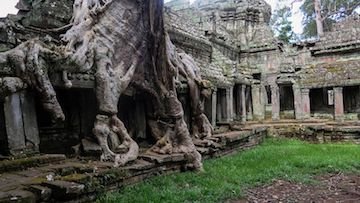
The third Buddhist Council was held at Pataliputra, in the seventeenth year in the reign of King Asoka around 255 B.C.; and was headed by a senior follower, named Moggaliputta-Tissa Thera. During the reign of Asoka, a number of non-orthodox Buddhists had joined the Asokarama monastery.
Because of this, the orthodox monks refused to perform the most important Uposatha ceremony for seven years. King Asoka was not happy about this, as he tried to bring about unity in the community of monks, and assigned one of his ministers to convince the orthodox monks of the Asokarama monastery to perform the Uposatha that year. The assigned minister misunderstood the orders he was given, and beheaded several monks. King Asoka was very upset when he heard what had happened, and went to the elder Moggaliputta Tissa, the most senior monk at present, and asked for advice on the matter. Moggaliputta convinced king Asoka that there had been no wrong-doing on his part, on the ground that he had not shown any deliberate intention in the wrong execution of his order, as it was misunderstood by his minister.
After this had transpired, the next step was to remove all the monks in the Asokarama monastery who did not adhere to the orthodox (vibhajjavada) doctrine. In the presence of Moggaliputta, king Asoka questioned the monks on their various doctrines, and all those holding unorthodox views were expelled from the Order, Moggaliputta decreeing that the orthodox doctrine (vibhajjavada) alone contained the teaching of the Buddha. Later, in association with one thousand arahants, Moggaliputta held the Third Council at Asokarama, with himself the leader of the Council, and compiled the Kathavatthuppakarana, a compilation text that deals with the points of controversy from the unorthodox schools.
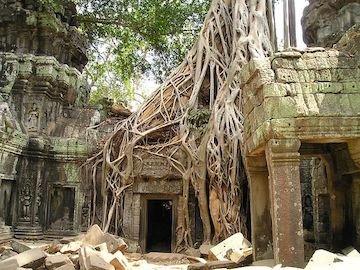
The Third Council lasted for nine months, and at the conclusion of the Council, Moggaliputta Tissa Thera sent out orthodox monks to go to the various regions of king Asoka’s large empire, to spread the recited teachings of the Buddha as declared valid at the Third Buddhist Council.
The historical accuracy of the Third Buddhist Council has not always been accepted by Buddhist scholars, but now it is generally accepted that the third Council did take place as a sectarian Theravada council. King Asoka, does not directly refer to the Council, yet some of his archeological pillar and rock edicts inscriptions that have been found, appear to provide evidence. That king Asoka is not directly referring to the third Council may be explained by the suggestion that he was not as closely involved with the proceedings of the Third Council as the Pali tradition has recorded it as in their texts. The main goal of king Asoka, was to not cause another split of the Sangha, but to bring unity among the Buddhist followers.
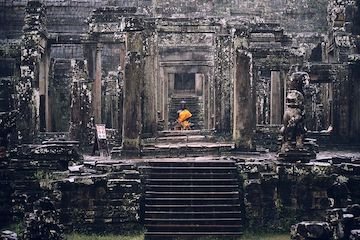
The account of the Third ‘Asoka’ Council is only to be found in the Pali commentaries (atthakatha) and the Ceylonese chronicles. Even the Cullavagga of the Vinaya pitaka does not mention it. The omission of this Council in non-Theravada sects, shows that this was a sectarian council. Both Chinese pilgrims Yuan Chwang and I-Tsing also do not mention this Asoka Council.
This council is ignored and considered invalid by Northern Buddhism, especially the Sarvastivada school, who’s forerunners were those ‘unorthodox’ monks that were compelled to leave Asokarama monastery. The Sarvastivada moved to Mathura and from thereon out spread to Gandhara and Kashmir later.
The traditional account of the Council may not be completely historical, but the events which led up to the Third Council appear to be. The split between the Sthaviravada and the Mahasamghika that took place in the Second Buddhist Council increased over time until it became untenable for the two schools to share the same location. The points of controversies, as detailed in the Kathavatthu text can be compared with the findings of Vasumitra of the Sarvastivada school and others, which shows that there is a degree of validity in the reality of the disagreements between the schools. After the Second Buddhist Council dealt with the Vinaya rules disagreements, according to the Sthaviravada, it seems like the main driving force for having the Third Council was to refute the tenets of the largest non-Sthaviravada schools.
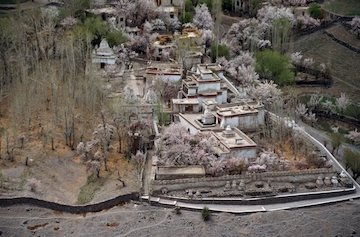
The Nikaya-sangraha text mentions the Mahasamghika school and shows that they did not pay attention to the treatment of the points of controversy in the Kathavattu, not even the refutations that were addressed towards their tenets. Instead, the Mahasamghika school held their own meeting in Kosambi, and recited and upheld their own collection of the teachings.
Fourth Buddhist Council
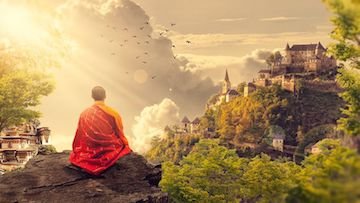
The fourth Buddhist Council was also named the ‘king Kanishka’ Council at Jalandhar in Kashmir, and was headed by Vasumitra around 100 A.D.
The spread of Buddhism in Gandhara and Kashmir, can be traced in both Pali and Sanskrit traditions, where the monk Madhyantika was responsible for the spread of Buddhism in these two regions. Madhyantika was Ananda’s disciple, and is recognized as a prominent teacher by the Sarvastivada school. The Chinese pilgrim Yuan Chwang confirms that Madhyantika taught Sarvastivada Buddhism in Kashmir, who explains that king Asoka not only sent Buddhist monks to Kashmir but also built monasteries there.
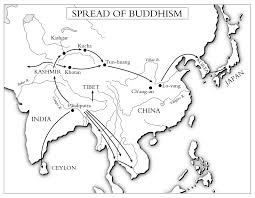
Taranatha, the 16th century historian, starts out his story about the Fourth Council with the conversion of king Simha of Kashmir to Buddhism. The story goes, that king Simha became an arhat and his name after ordination was Sudarsana. He taught the religion in Kashmir. At that time, Kanishka was the king of Jalandhara. He heard of Sudarsana and came to Kashmir to listen to his Buddhist teachings.
The Buddhist Sangha as a whole had been divided into eighteen schools around the country. The Venerable Parsva had come to Kashmir from the east, and advised king Kanishka to collect all the monks at Kundalavana monastery (in Kashmir). Five hundred Arhats, five hundred Bodhisattvas and five hundred Panditas (not stream-enterers) took part in the Council. An attempt was made to reconcile the conflicting opinions of the different schools and settle once more the Vinaya, Sutra and Abhidharma texts.
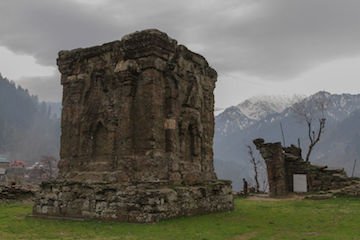
The existence of a class of monks called Bodhisattvas at the time of the Fourth Council is indicative of traces of Mahayana. The Divyavadana mentions the existence of a class of monks called bodhisattva-jatika, along with a side-note that they were not looked upon with favor by the Hinayanists. Three days after the first ordination according to the rules of conduct (pratimoksa), the monks partake in a special ordination according to the Brahmajala-sutra and enter the Bodhisattva path.
Bu-ston, the Tibetan historian, gives an account that is similar, adding that “after reciting the texts, it was agreed upon that the eighteen schools’ tenets were all considered the teachings of the Buddha.” This acknowledgement must have been one of the main reasons why this council is ignored and considered invalid by Southern Buddhism of the Theravada school.
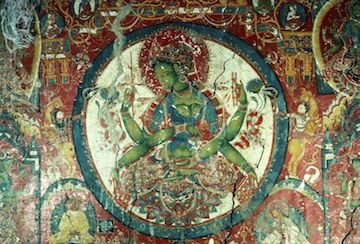
The Chinese seventh century A.D. pilgrim Yuan Chwang’s account is essentially the same. He attributes the session of the Council to the confusion that Kanishka had, while listening to the conflicting interpretation of Buddha’s teachings as given by the representatives of the different schools. Parsva explained to the king the cause of his confusion and advised him to hold a Council in order to bring together the varying interpretations of the various schools that were present.
Yuan Chwang adds that in this Council several commentaries on the Sutra, Vinaya and Abhidharma were written and called the Upadesa-sastras and Vibhasa-sastras, in which the original texts and their different interpretations were discussed. King Kanishka, records Yuan Chwang, had all the texts committed onto copper plates, enclosed in stone-boxes for longevity, and deposited them in a stupa made especially for the purpose of preserving these texts.
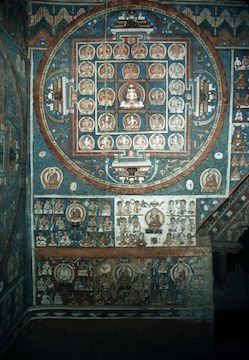
Paramartha, in his ‘Life of Vasubandhu’, refers to the Fourth Council, and writes that Katyayaniputra went to Kipin (Kashmir) and there, with the co-operation of 500 Arhats and 500 Bodhisattvas, arranged the Sarvastivada Abhidharma texts in eight sections, such as: prajna, dhyana, etc., and called it jnana-prasthana-sutra. A commentary was written on the same and was called Vibhasa. He then sent for Asvaghosa, who was residing at Sravasti and requested him to give the Vibhasa texts a proper literary shape.
By the expression Vibhasa-sastra, Paramartha refers to the Sarvastivada Abhidharma texts, while Yuan Chwang refers to the Abhidharma as well as the Sutra and Vinaya texts, the commentaries on Sutras being only distinguished as Upadesa and not as Vibhasa Sastras.
In the next article, the general history of Buddhist schools according to the ‘Northern Buddhists’ of the Sarvastivada school will be discussed.

Pictures From Cross-Cultural Influences in the Early Buddhist Art of Ladakh
Pictures From Sharda, Neelum Valley Pakistan
- Introduction to the history of Buddhist Councils and Schools-Part 1
- The Buddhist Councils — Who, when, where, and why?Part 2
- The Ten Stages of the Mahayana Bodhisattva Path-The Two Preliminary Stages-Part 1
- The Ten Stages of the Mahayana Bodhisattva Path-The Two Preliminary Stages-Part 2
- The Ten Stages of the Mahayana Bodhisattva Path-The Two Preliminary Stages-Part 3
- The Ten Stages of the Mahayana Bodhisattva Path-The Two Preliminary Stages-Part 4
- The Ten Stages of the Mahayana Bodhisattva Path-The Two Preliminary Stages-Part 5
- The Ten Stages of the Mahayana Bodhisattva Path-The Two Preliminary Stages-Part 6
- The Ten Stages of the Mahayana Bodhisattva Path-The Two Preliminary Stages-Part 7
- The Ten Stages of the Mahayana Bodhisattva Path-The Two Preliminary Stages-Part 8
- The Ten Stages of the Mahayana Bodhisattva Path-The Two Preliminary Stages-Part 9
- The Ten Stages of the Mahayana Bodhisattva Path-The Two Preliminary Stages-Part 10
- The Ten Stages of the Mahayana Bodhisattva Path-The Two Preliminary Stages-Part 11
- The Deathless In Buddhism
- The "Timeless" Teaching-Being Beyond Temporality
- The Nine Successive Cessations In buddhist Meditations - Part 1
- The Nine Successive Cessations In buddhist Meditations - Part 2
- The Nine Successive Cessations In buddhist Meditations - Part 3
- The Twelve Links Of Dependent Origination
- THINGS to DEVELOP and THINGS to AVOID
- The First Noble Truth
- The Second Noble Truth
- The Third Noble Truth
- The Fourth Noble Truth
- 10 Fold Path Series
- EATING MEAT — WHY THE BUDDHA WAS NOT A VEGETARIAN
I will flag comment spam at 1% strength. If you keep on spamming my post, I will flag you at 100%. I don't care if you have limited English abilities, write a couple of sentences about this article, no copy-paste, please. I will flag: one sentence comments, links to your blog and begging for up-votes and follows. Also, I will flag comments that have nothing to do with my blog's article. I will also check your comment section to see if you have been comment spamming on other blogs.


 A link to My Blog
A link to My Blog
@reddust this is really informative. I remember some of it but most if it is new to me. This is a real solid read. Thanks for sharing this :-)
Emperor Ashoka's contribution to Buddhism has been great and indisputable. As Kshatriya himself he has been involved in the politics and wars of that time but towards mid of reign he turned towards Buddhism and sought unify and consolidate it at his time.
I am not really sure of the exact dates as to the order of the events but his early life was spent partly in wandering and politics and than as a king and in the wars of the region. It is said that after war of Kaling, he found the bloodshed and the brutality of it really devastating and chose to do something about it. His kingdom and court both had some Buddhist influences and it is suggested that a part of his early life was also spent in interaction with monks.
Although people somehow think that Buddhism magically spread around the whole world but as you mention, effort had to be made before that happened. Ashoka's contributions are something that I have always admired.
Downvoting a post can decrease pending rewards and make it less visible. Common reasons:
Submit
I will give the compliment to my researcher, my husband @hashcash, we both thank you for your support. I remember reading about Ashoka in some of my first lessons in Buddhism. He was a violent and bloody ruler, but when he was introduced to Buddhism, he completely changed and became a wise and kind leader. However his practice of nonviolence left his borders open to hostile forces, so one must practice wise non-violence, the same goes for compassion. Wise compassion helps people take care of themselves and not become dependent.
Downvoting a post can decrease pending rewards and make it less visible. Common reasons:
Submit
Hey @reddust!
You guys have done really solid research on the subject. The subject matter is itself quite complicated given the number of traditions available and not to mention its complicated evolution during the past millennia, enormous amount of time and energy must've gone into it. You really have my gratitude for sharing it all here.
............ and of course thanks to your husband too :D
Downvoting a post can decrease pending rewards and make it less visible. Common reasons:
Submit
Most of the work is research, I know the history but not the details, my husband is a detail man and perfect for the job. I am happy you enjoy my Buddhist post @hashcash <3
Downvoting a post can decrease pending rewards and make it less visible. Common reasons:
Submit
in Islam the division of the Ummah occurred during the reign of ustman ibn Affan, that is Abdullah ibn Saba as the instigator of rebellion, from the political problem penetrated to the flow of belief, which came to be known as the origin of Shi'i
Downvoting a post can decrease pending rewards and make it less visible. Common reasons:
Submit
@steemitcountry, I keep missing your comments on my other posts. I am so sorry by the time I post and respond to questions I log out of steemit for the day. You comment in the evening, your daytime and I am off line!
I think these schisms happen because we all are human. Hopefully we can evolve out of our combative natures.
Downvoting a post can decrease pending rewards and make it less visible. Common reasons:
Submit
we now do not have a laptop anymore, my wife's laptop is broken, so now we use one computer in turn, and internet connection again is very bad, I am always late to comment on every post you friend, but I always follow your post ,,,
I really like the post about budha ,,, by the way if the image of the house you picture is ready for perfect?
Downvoting a post can decrease pending rewards and make it less visible. Common reasons:
Submit
it seems that all religions there are divisions, what do you think the positive side of the divisions in Buddhism?
Downvoting a post can decrease pending rewards and make it less visible. Common reasons:
Submit
@steemitnatural, it happens in families, businesses, governments, where ever humans gather there will be politics and arguments...hopefully we can grow out of this combative nature someday.
Downvoting a post can decrease pending rewards and make it less visible. Common reasons:
Submit
I also hope so my friend
Downvoting a post can decrease pending rewards and make it less visible. Common reasons:
Submit
From my point of view, my experience and research - Teaching Researcher - I conclude that, in both Buddhism and Christianity, I apologize for always making the comparison, but I was brought up in a Catholic environment against which I am struggling - the truth has been distorted, and that has happened over the years and because of the scientific tendency of the human being's approach.
For many years, I have read in countless pages that there are "hidden" documents where true Buddhist and Christian doctrine has been preserved for a few. Therefore, there is a management of the precepts to influence the majority and have a certain dominance.
I continue to turn the subject upside down, and I have so many concerns that I will summarize and share them in a new commentary to lighten the load and find the right answers.
Downvoting a post can decrease pending rewards and make it less visible. Common reasons:
Submit
My meditation practice called anapana and vipassana taught by SN Goenka is from Burma. This practice was only for monks and nuns. Lay people in Theravada do not become enlightened until they become a monk or nun. Goenka and his teachers broke that rule to help lay people find peace instead of just the merit of supporting monks and nuns so they can eventually take rebirth and become a monk or a nun. You can see this power struggle happening everywhere it is human nature to want to withhold information to give one special status, wealth, and power.
I am keeping up on the news in South America. Venezuela isn't the only country struggling with corruption and poverty. Where ever there is a corrupt monarchy or government there is poverty and the extremely rich. I hope the people can find a way out of this mess without the cycle of extreme violence which births a new corrupt government.
Downvoting a post can decrease pending rewards and make it less visible. Common reasons:
Submit
Yes dear friend @reddust, my intention is not that the situation in which we live in Latin American countries should be recognized or not; nothing political. I want to be one of the first to express my ideas, but internet services have been rationing since last week.
Thank you again for your patience and kindness in answering my comments. Congratulations, my friend.
Downvoting a post can decrease pending rewards and make it less visible. Common reasons:
Submit
Writing about the conflict in Buddhism reminds me of the conflicts we all experience. I think the articles reflect what we all go through. I hope your communication lines stay open; I enjoy talking with you @amigoponc.
Downvoting a post can decrease pending rewards and make it less visible. Common reasons:
Submit
I read this for the first time. It's a little deep. Thanks for sharing. Dear @reddust What exactly do you mean here?
Downvoting a post can decrease pending rewards and make it less visible. Common reasons:
Submit
This is the beginning of what we call Mahayana Buddhism, they do not follow "all" the codes of conduct in the vinaya of Theravada buddhism, which called the Sarvastivada "unorthodox." Plus the Sarvastivada followed the Bodhisattva path and the Arahat path....
Downvoting a post can decrease pending rewards and make it less visible. Common reasons:
Submit
Very interesting. I want to read it again. I will investigate @reddust
Downvoting a post can decrease pending rewards and make it less visible. Common reasons:
Submit
Very interesting. I want to read it again. I will investigate @reddust
Downvoting a post can decrease pending rewards and make it less visible. Common reasons:
Submit
You know you are doing best work with your this series i have added many of knowledge from here from this series. This article focuses on the picture of mind and mental phenomena that emerges from the canonical literature,.
This i s in my knowledge Buddhist conceptions of mind evolved from early attempts to offer a systematic account of human experience as described in the large body of discourses attributed to the Buddha.....
Downvoting a post can decrease pending rewards and make it less visible. Common reasons:
Submit
@abdt, have you ever wondered what the mind is and where it is located? There are huge arguments about this in our scientific community. The same arguments have taken place in Buddhism for 2500 hundred years.
If you are going to train your mind you should know something about it...hahaha ;-)
Mind and Matter (Nama-Rupa)
Downvoting a post can decrease pending rewards and make it less visible. Common reasons:
Submit
You put a lot of work into these articles and that speaks of your conviction of your faith in Buddhism. Thanks for sharing what you believe. Blessings @reddust.
Downvoting a post can decrease pending rewards and make it less visible. Common reasons:
Submit
Writing the series of Buddhist articles have been done with Gratitude, my teachers helped me learn how to take care of myself and stop being a victim. After struggling with PTSD from an abusive childhood and first marriage I was a wreck. My teachers helped me put myself together, and now I am functioning better than I ever would have if I hadn't been abused. In a way the abuse I suffered lead me to find freedom from the conditioning all use humans have to live through. This is my thank you and I am glad you enjoy my post @enjoywithtroy.
Downvoting a post can decrease pending rewards and make it less visible. Common reasons:
Submit
Pretty soon you shall be a "bodhisattva" if you are not one yet, tehe. Pls help me 1st lol. Love your thorough buddhist post <3.
Downvoting a post can decrease pending rewards and make it less visible. Common reasons:
Submit
I will teach you how to help yourself when I become a Bodhisattva, at this time we are good friends and we can help each other.
Ananda is my favorite out of all the Buddha's friends. He was the champion for women attaining enlightenment and joining the sangha as a monastic. I always wondered what happened to Ananda and it looks like his foremost student went to Kashmir, which means Ananda influence is strong within the Mahayana traditions which are more accepting of women and lay people attaining enlightenment.
Good Friends
Downvoting a post can decrease pending rewards and make it less visible. Common reasons:
Submit
Good Friends indeed. Ty reddust.
Downvoting a post can decrease pending rewards and make it less visible. Common reasons:
Submit
Congratulations @reddust really is that the wisdom you have acquired over the years is very good, I hope to get into your publications to understand these topics that are very interesting
Downvoting a post can decrease pending rewards and make it less visible. Common reasons:
Submit
Thank you @rataelamor
Downvoting a post can decrease pending rewards and make it less visible. Common reasons:
Submit
Dear @reddust It's very educational post.
History helps us to learn from the past
Downvoting a post can decrease pending rewards and make it less visible. Common reasons:
Submit
Thank you @joniprins
Downvoting a post can decrease pending rewards and make it less visible. Common reasons:
Submit
Buddha is the sea of knowledge as he spent his whole life to proclaim the knowledge around the world. And the Buddhist council is the sign of his greatness. Really i impressed to read about the 3rd and 4th Buddhist council. Thanks a lot @reddust to share the valuable content with us. Eagerly waiting for the next episodes.
Downvoting a post can decrease pending rewards and make it less visible. Common reasons:
Submit
Thank you @msena
Downvoting a post can decrease pending rewards and make it less visible. Common reasons:
Submit
Very well post
Thanks you for the sharing post 😏😏
Downvoting a post can decrease pending rewards and make it less visible. Common reasons:
Submit
Thank you @abu-bokor
Downvoting a post can decrease pending rewards and make it less visible. Common reasons:
Submit
Excellent series containing tons of informative information!
Downvoting a post can decrease pending rewards and make it less visible. Common reasons:
Submit
Thank you @oraclefrequency
Downvoting a post can decrease pending rewards and make it less visible. Common reasons:
Submit
Very good explanation of the third and fourth Buddhist council. People full of wisdom gathered for a unique purpose. Keep developing these topics that are of great help to understand this religion that many are unaware.
Downvoting a post can decrease pending rewards and make it less visible. Common reasons:
Submit
Thank you @carrie, the articles reveal even enlightened people can disagree.
Downvoting a post can decrease pending rewards and make it less visible. Common reasons:
Submit
Very good post, Amiga @reddust Very explanatory, I missed your posts but I really liked this topic in particular. I got a bit distracted with your other art publications that are also interesting. Good luck, keep harvesting
Downvoting a post can decrease pending rewards and make it less visible. Common reasons:
Submit
Thank you @deisydavi
Downvoting a post can decrease pending rewards and make it less visible. Common reasons:
Submit
There are many old and historical places in your post. Many of these places are hidden in history.
Downvoting a post can decrease pending rewards and make it less visible. Common reasons:
Submit
Thank you @raselkhan566
Downvoting a post can decrease pending rewards and make it less visible. Common reasons:
Submit
very interesting history.great blog.
Downvoting a post can decrease pending rewards and make it less visible. Common reasons:
Submit
Hey, @reddust Really great work my dear friend and I am glad to seen your daily post .many many thanks for sharing with us your important post.
Downvoting a post can decrease pending rewards and make it less visible. Common reasons:
Submit
@reddust I am always loved your all post...you really post well....your think is good....best of luck
Downvoting a post can decrease pending rewards and make it less visible. Common reasons:
Submit
in Islam the division of the Ummah occurred during the reign of ustman ibn Affan, that is Abdullah ibn Saba as the instigator of rebellion, from the political problem penetrated to the flow of belief, which came to be known as the origin of Shi'i
Downvoting a post can decrease pending rewards and make it less visible. Common reasons:
Submit
Emperor Ashoka's contribution to Buddhism has been great and indisputable. As Kshatriya himself he has been involved in the politics and wars of that time but towards mid of reign he turned towards Buddhism and sought unify and consolidate it at his time
Downvoting a post can decrease pending rewards and make it less visible. Common reasons:
Submit
Very well post
Thanks you for the sharing post 😏😏
Downvoting a post can decrease pending rewards and make it less visible. Common reasons:
Submit
Pretty soon you shall be a "bodhisattva" if you are not one yet, tehe. Pls help me 1st lol. Love your thorough buddhist post <3.
Downvoting a post can decrease pending rewards and make it less visible. Common reasons:
Submit
Congratulations @reddust really is that the wisdom you have acquired over the years is very good, I hope to get into your publications to understand these topics that are very interesting
Downvoting a post can decrease pending rewards and make it less visible. Common reasons:
Submit
Very interesting post.luvly history
Downvoting a post can decrease pending rewards and make it less visible. Common reasons:
Submit
amazing post, unique photography I really like this post
Downvoting a post can decrease pending rewards and make it less visible. Common reasons:
Submit
I see that Buddhism had also sectarian and doctrine based disputes amongst factions. In modern times, do people still take sides? What do you do with disagreement?
Downvoting a post can decrease pending rewards and make it less visible. Common reasons:
Submit